Sourdough Bread Recipe
Published April 29, 2020. This post may contain affiliate links. Please read my disclosure policy.
Learn how to make an absolutely delicious sourdough bread recipe every single time using my foolproof easy to follow steps.
I’m a huge homemade bread fan and perfecting the art of making it is incredibly fun. If it doesn’t matter if I’m making Naan or a Kamut Flour Loaf, it’s always so rewarding.
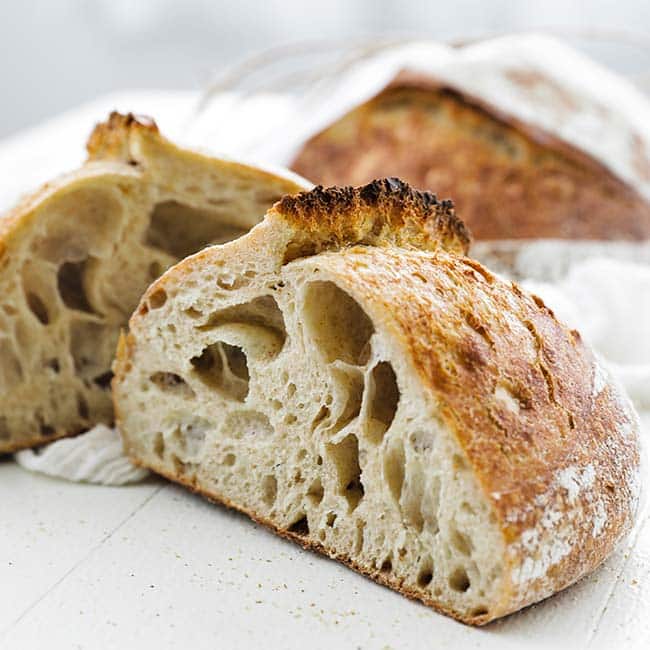
Sourdough
Just like I say for homemade pasta, there is nothing like homemade bread, nothing. Sourdough is essentially the original leavened bread recipe using a natural yeast starter. It has a unique slightly sour taste and when made correctly is packed with beautiful air pockets and an amazing outer crust.
While you may immediately think of San Francisco when it comes to sourdough bread, Egypt is the early creators of this. Wild yeast would get into the dough mixes and when it baked, it rose to make it a leavened loaf.
What Make’s It Sour
The sour flavor in the bread comes from the fermentation process that takes place when preparing your starter. When you incorporate that sour starter into the bread it also bulk ferments for several hours making it a tad sourer.
If you love that flavor and want it to be more intense than do not go through the starter discard process, simply add it in the morning straight to your bread after it autolysis.
Health Benefits of Sourdough Bread
There are incredible health benefits to making and eating it. First and foremost, you use a few ingredients that are all-natural, which is always better than the bread from the store that has 27 things in it you can’t pronounce.
Sourdough is jam-packed with daily vitamins and minerals such as iron and Vitamin B. To me the most important part is the natural probiotics that are in the bread to aid in digestion.
During the bulk fermentation process, the good bacteria that have been created in your starter will break down the gluten in your autolyzed dough making it easier to digest. The result is a delicious bread that isn’t going to leave you bloated, and my personal belief is the gluten intolerant could most likely be able to eat and digest this.
What’s In It
There are only 3 ingredients in this recipe consisting of flour, water, and salt, that’s it. With that being said, you will need to have an active starter before making this sourdough recipe.
What Do You Cook It In
The best thing to cook it in is a cast iron pan that has a very tight lid. The tight lid is key to help to keep moisture in the pan when it is cooking which will assist in the crust, tenderness, and moistness in the loaf.
I am a huge fan of the Challenger bread pan as it is designed specifically for baking amazing bread. Here are a few other things you can use:
- Dutch oven pot with a lid
- Lodge combo pan
- High-temperature pot with a lid
- Pizza stone with a pan of water on a separate rack
- Cookie sheet pan
Tools Needed to Make It
Here is what you will need to make this sourdough:
- Gram Scale
- Large Bowl
- Banneton
- Kitchen Towel
- Plastic Containers
- Pot and Lid
How to Make It
Follow these foolproof steps to make delicious sourdough bread:
- Feed your starter and activate it by placing it in the oven, with only the oven light on and leaving the oven door cracked for about 4 hours or until it has at least doubled in size and is beginning to fall. (See chef notes below)
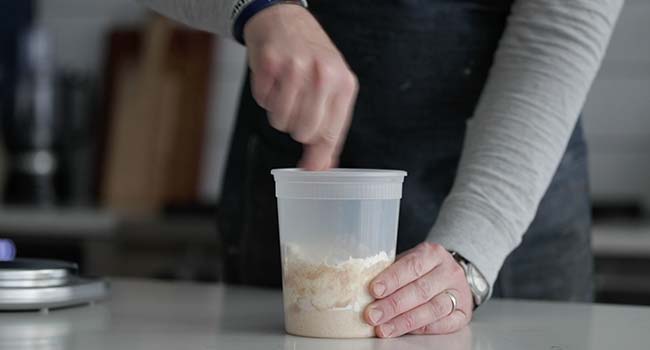
- Once the starter begins to fall begin the autolyse process by mixing together your flour and filtered water. Cover with a damp towel and place it in the oven next to your starter and autolyse for 30 minutes.
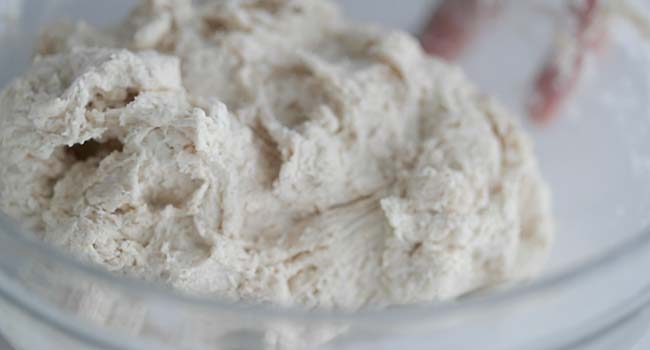
- Add your starter to the dough and mix in, which takes about 90 seconds. Cover with a damp towel and place it in the oven and autolyse for 30 minutes.
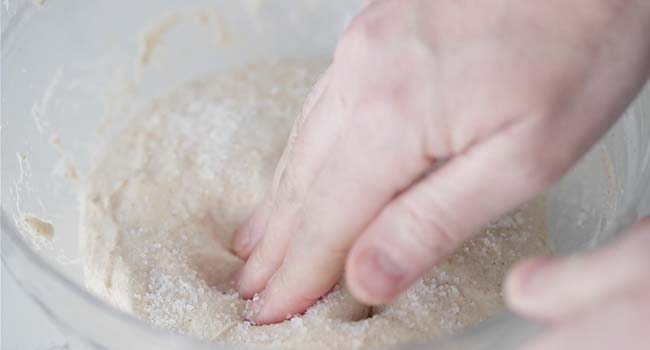
- Measure out and add the salt to the dough, wet your hands with bottled water, and mix it in until combined, which takes about 90 seconds. Cover with a damp towel and place it in the oven for 60 minutes.
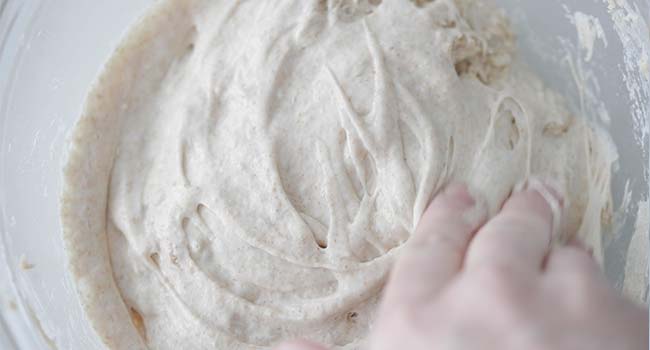
- Perform a series of folds to the dough for about 90 to 120 seconds to strengthen the gluten in the dough so that it will eventually hold shape. Cover with a damp towel and add it to the oven with the light on for 60 minutes and repeat this process 3 more times.
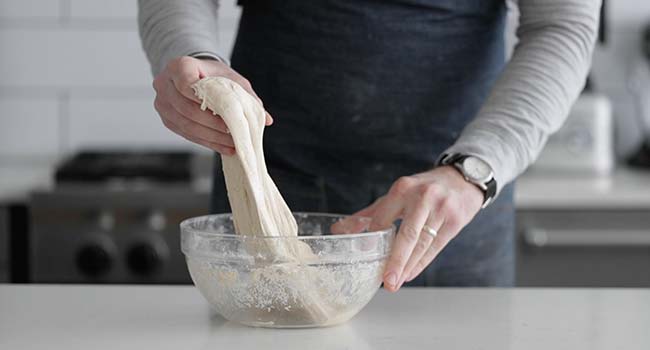
- After the last fold to the dough Cover with a damp towel and place it in the oven for only 30 minutes this time.
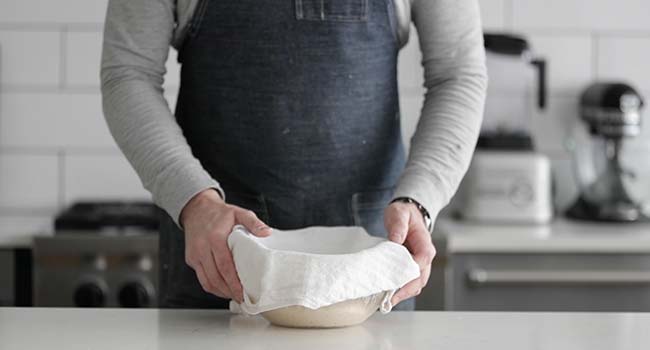
- Remove the dough and place it directly on your countertop. Rub a little flour to the top using your hand and curl in the bottom of it using a bench knife to make it taught and tight on top.
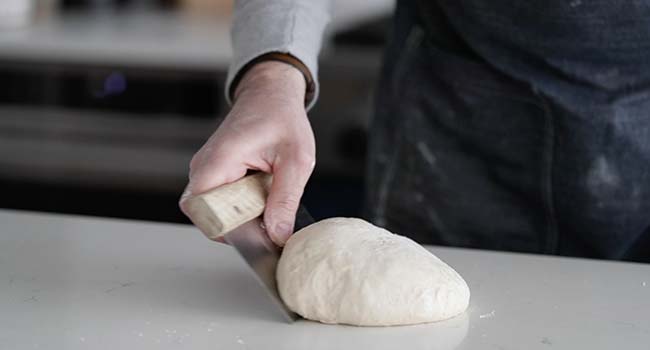
- Flip the dough over and stretch out as much as you can to a rectangle shape.
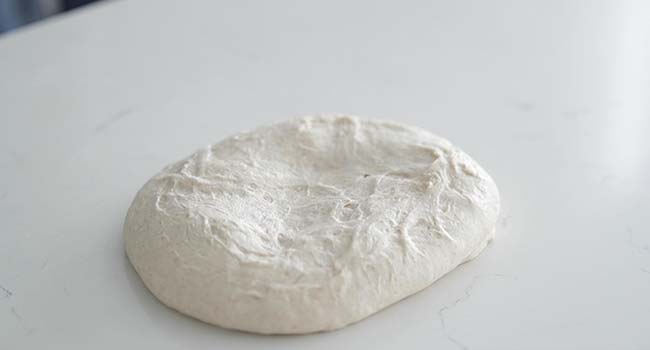
- Fold the right side to the left side over to cover about 2/3 of the dough.
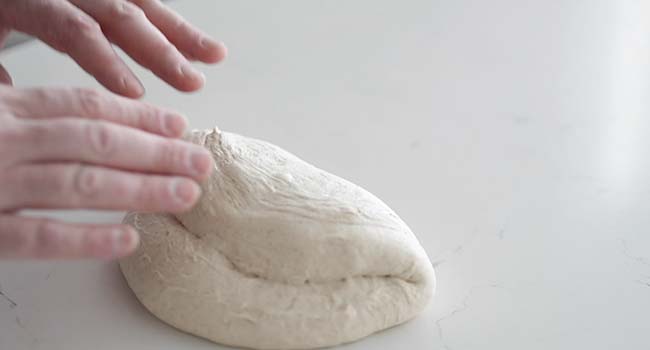
- Now fold the left side as much as you can over the right side.
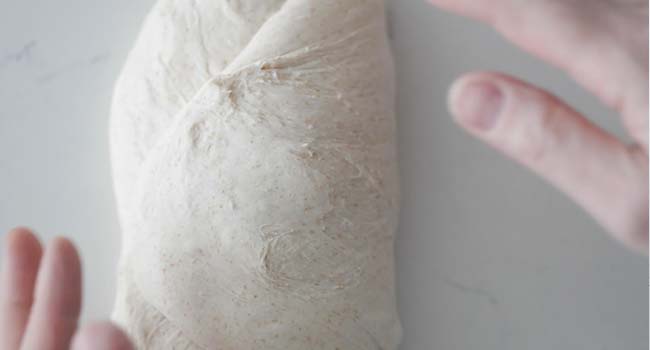
- Starting from the bottom roll up the dough to the front pulling gently making it as taught and as tight as possible.
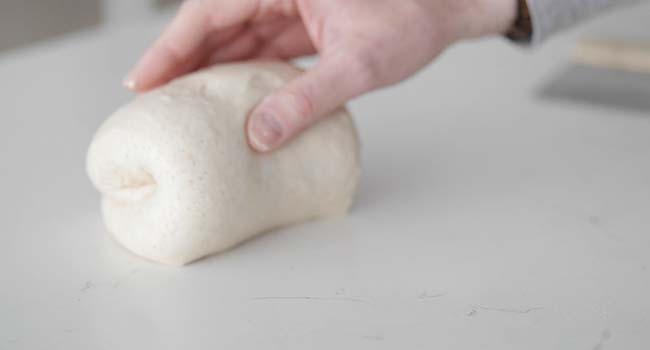
- Transfer the dough seam side up into a lightly floured banneton.
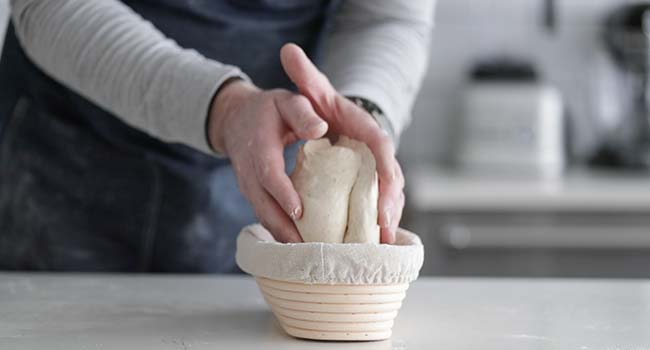
- Pinch together the seams to help create more air pockets in the bread and to aid in the rising process.
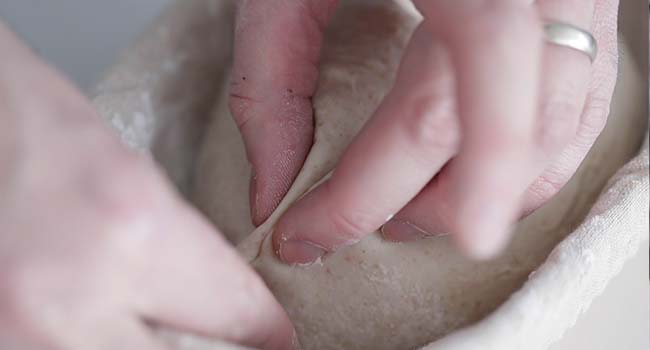
- Cover in plastic, a towel or in a large plastic zip bag and refrigerate for 12-16 hours or up to 24 hours.
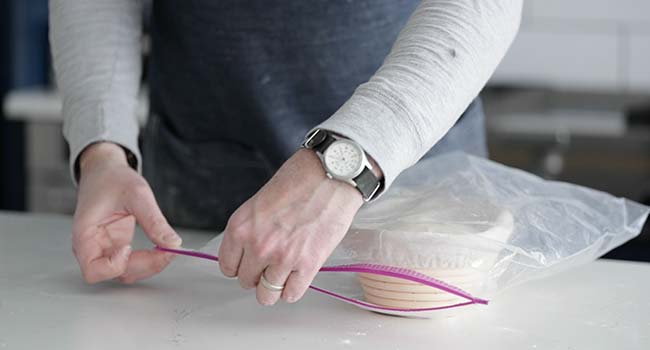
- The next morning preheat your pan in the oven at 500° for 30 minutes and then remove the lid and sprinkle cornmeal onto the bottom of the hot pan and then also on top of the dough.
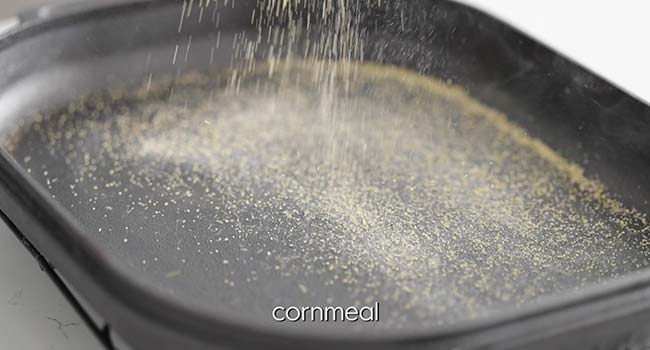
- Immediately flip the dough in the banneton over to the center of the hot pan.
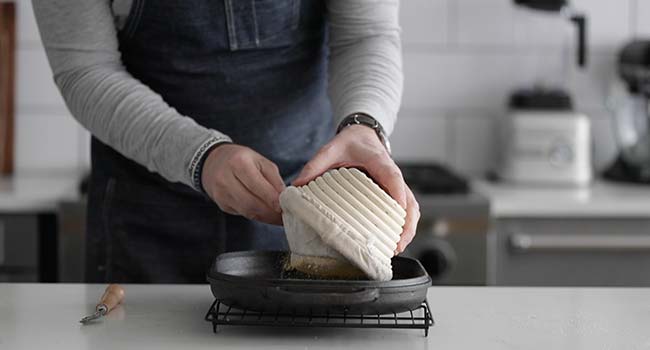
- Score the bread using a razor, sharp knife, or bread knife.
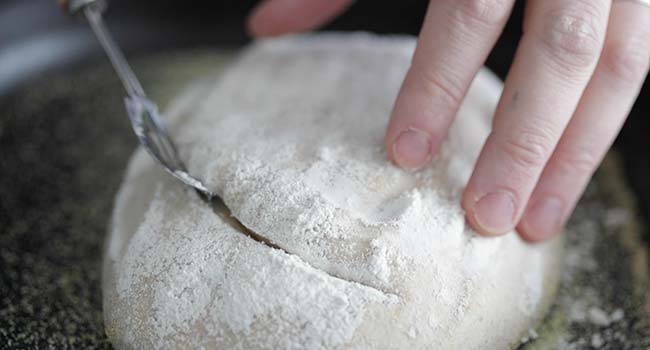
- Place the lid onto the pan and bake for 20 minutes.
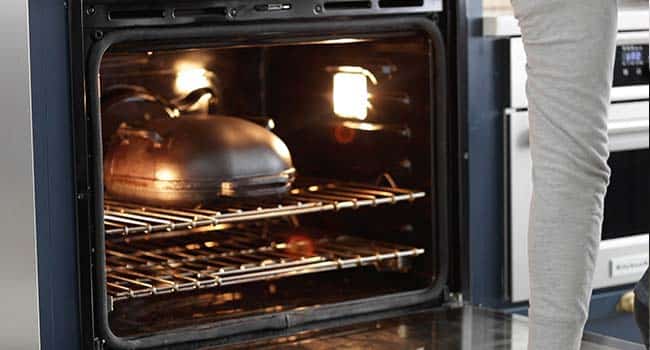
- Remove the lid and bake for 15 more minutes to help with brown the bread.
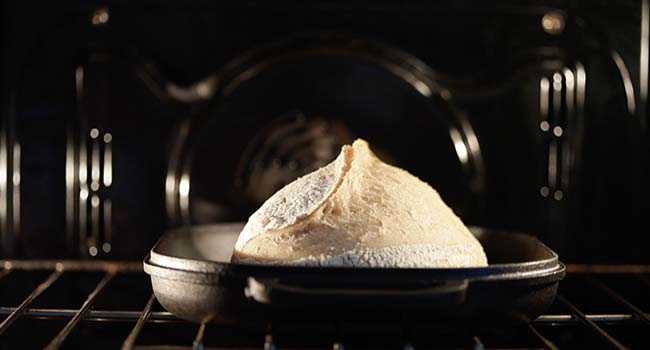
- Cool on a rack to room
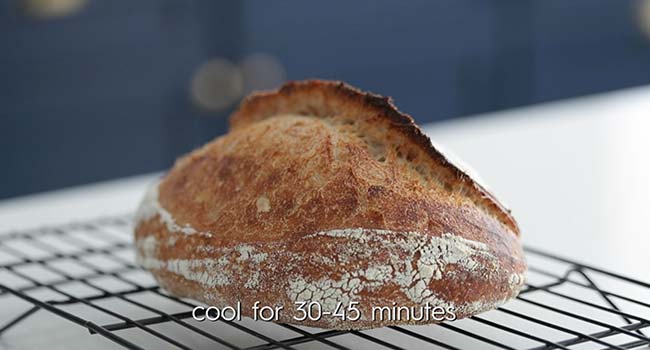
Make-Ahead and Storage
Make-Ahead: You can make this bread up to 1 day ahead of time.
How to Store: Store this bread wrapped in parchment paper and keep at room temperature for up to 4 days. You can cover and keep in the refrigerator for up to 7 days.

chef notes + tips
- The water temperature should be between 30-33° C or 87-93° F and can be warmed up in a pot or in the microwave.
- To make a proofing environment if you don’t have a bread proofer, simply turn the light on in your oven and leave the door cracked. It will be between 78° and 84° in there which is perfect.
- What Is Autolyse: This is the process of mixing your flour with your warm water until combined and let the natural starches and sugars start to work before adding in your levain or yeast. This helps the rising, forming, and overall bread-making process.
- You will know when it’s time to begin the autolyse process when your starter begins to fall from its peak volume.
- It’s important to use filtered water in making bread as too much chlorine in tap water will kill the starter.
- The reason for using all-purpose flour in the recipe is because it is more commonly used and acquired in households, plus during the stay at home orders, it’s hard to get bread flour.
- If you want to use bread flour instead of all-purpose flour, increase the amount of water by 5-10%.
- When performing the folds be sure not to pull so hard you tear the dough. Watch the video below to see how to properly do it.
Here are some affiliate links to the products I used in this video:
- Plastic containers for starter
- Bowls
- Scale
- Banneton
- Kitchen towel
- Challenger bread pan
- Bench knife
- Hefty bags
- Bread scorer
- Resting rack
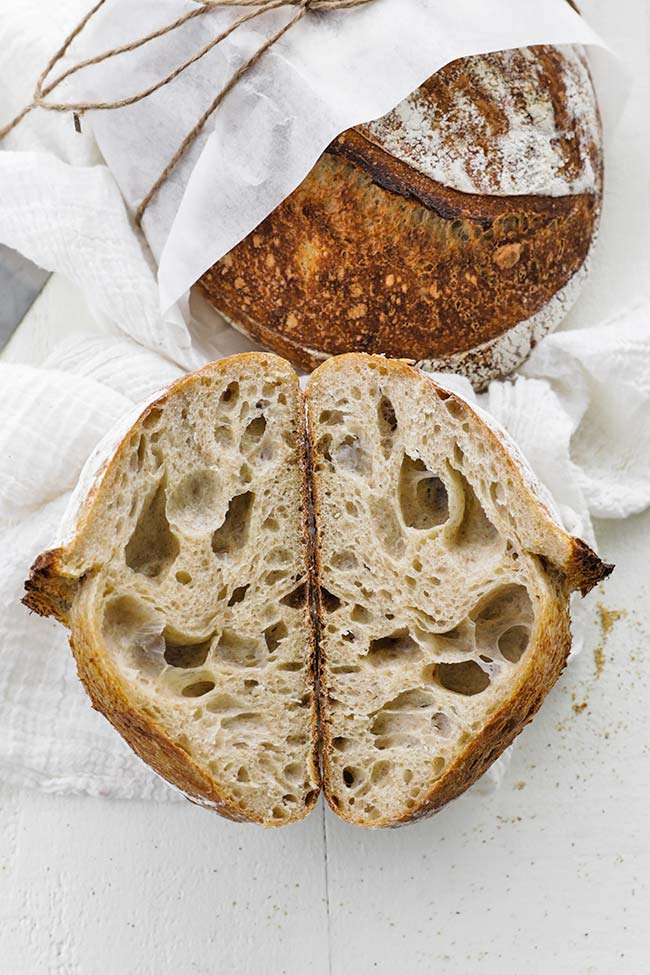
More Amazing Bread Recipes
Be sure to follow me on Facebook, Youtube, Instagram, and Pinterest, and if you’ve had a chance to make this then definitely drop me a comment and a rating below!

Video
Sourdough Bread Recipe
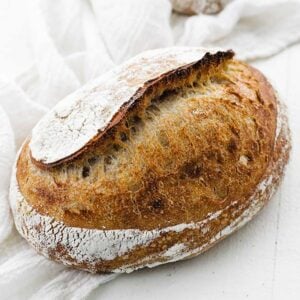
Ingredients
For the Starter:
- 75 grams of active starter
- 55 grams all-purpose flour
- 20 grams whole wheat flour
- 75 grams warm water
For the Bread:
- 350 grams all-purpose flour
- 50 grams whole wheat flour
- 75 grams fed starter
- 14 grams sea salt
- 275 grams warm water + extra for dipping
Instructions
- Feed your starter and place in a warm place for 4 hours or until it has at least doubled in size and is beginning to fall. (See chef notes below)
- Once the starter begins to fall being the autolyse process by mixing together your flour and filtered water. Cover with a damp towel and place it in the oven next to your starter and autolyse for 30 minutes.
- Add your starter to the dough and mix in, which takes about 90 seconds. Cover with a damp towel and place it in the oven for 30 minutes.
- Measure out and add the salt to the dough, wet your hands with bottled water, and mix it in until combined, which takes about 90 seconds. Cover with a damp towel, and place it in the oven for 60 minutes.
- Perform a series of folds to the dough for about 90 to 120 seconds to strengthen the gluten in the dough so that it will eventually hold shape. Cover with a damp towel and place it in the oven for 60 minutes and repeat this process 3 more times.
- After the last fold to the dough, cover with a damp towel and place it in the oven for only 30 minutes this time.
- Remove the dough and place it directly on your countertop. Rub a little flour to the top using your hand and curl in the bottom of it using a bench knife to make it taught and tight on top.
- Flip the dough over and stretch out as much as you can to a rectangle shape. Fold the right side to the left side over to cover about 2/3 of the dough. Now fold the left side as much as you can over the right side. Starting from the bottom roll up the dough to the front pulling gently making it as taught and as tight as possible.
- Transfer the dough seam side up into a lightly floured banneton and pinch together the seams to help create more air pockets in the bread and to aid in the rising process.
- Cover in plastic, a towel or in a large plastic zip bag and refrigerate for 12-16 hours or up to 24 hours.
- The next morning, preheat your pan in the oven at 500° for 30 minutes.
- Next, quickly sprinkle cornmeal into the bottom of the pan. In addition, sprinkle cornmeal to the top of the dough just to make sure it doesn’t stick.
- Immediately flip the dough in the banneton over to the center of the hot pan and score the bread using a razor, sharp knife or bread knife.
- Place the lid onto the pan and bake for 20 minutes.
- Remove the lid and bake for 15 more minutes to help with brown the bread and cool on a rack to room temperature.
Notes
- The water temperature should be between 30-33° C or 87-93° F and can be warmed up in a pot or in the microwave.
- Make-Ahead: You can make this bread up to 1 day ahead of time.
- How to Store: Store this bread wrapped in parchment paper and keep at room temperature for up to 4 days. You can cover and keep in the refrigerator for up to 7 days.
- To make a proofing environment if you don’t have a bread proofer, simply turn the light on in your oven and leave the door cracked. It will be between 78° and 84° in there which is perfect.
- What Is Autolyse: This is the process of mixing your flour with your warm water until combined and let the natural starches and sugars start to work before adding in your levain or yeast. This helps the rising, forming, and overall bread-making process.
- You will know when it’s time to begin the autolyse process when your starter begins to fall from its peak volume.
- It’s important to use filtered water in making bread as too much chlorine in tap water will kill the starter.
- The reason for using all-purpose flour in the recipe is because it is more commonly used and acquired in households, plus during the stay at home orders, it’s hard to get bread flour.
- If you want to use bread flour instead of all-purpose flour, increase the amount of water by 5-10%.
- When performing the folds be sure not to pull so hard you tear the dough. Watch the video below to see how to properly do it.





Followed this recipe for my very first sourdough loaf and it came out beautifully! I love the videos and learning the why behind the what. My whole family raved about how good it tasted!
I made this again. It comes out fantastic every time
I have several bread recipes but THIS IS my favorite sour dough!!! Wonderful especially combined w his
Homemade butter!!! YUMMO!!!
I am Using this technics to make my sourdough bread for almost 2 years now with great success. Adjusted the recipe little bit to my liking. To bake I use Le Creuset cast iron and parchment paper. Thank you so much for teaching me! I am from Europe and was missing this kind of bread for years, thanks to you I can make bread I like again and it is much healthier then the store buy one.
Thank you ChefBilly such a privilege to enjoy your teaching 💗videos 😁😋
Great tasty recipe’s Chef Billy thank you
Thank you Chef Billy 😋☺️
Your recipes are the best thing to happen to my family! Amazing bread baking guidance!
I’ve made this several times. It’s a big hit in my house and doesn’t hang around long. Thanks for the instructions.
What excellent instruction(s). Always my go to for recipes and this bread recipe is so good!
Where do you get a starter?
you make it.
Absolutely beautiful bread! Thank you Chef Billy for making my sourdough journey a lot lease confusing with your technique. This loaf turned out increadible!!! I’m doubling the ingredients for two loafs next time.
Talking about a great sourdough bread recipe! This is the one! Enjoy folks!
I have made this 3 times now. Great recipe.
fantastic!
Gosh Chief walking past a bread shop smells amazing and then you want abit tasty still warm bread 😁😋👋
Is there a brand of sourdough starter that you use? Do you keep it going in the fridge or just start fresh every time? I’ve been known to lose patience with feeding and maintaining starter in the fridge…
you make it yourself.
1st try good. Second time even better
Thank you Chef Billy 😋😁🤩👋
my pleasure
I used your starter recipe with 1/6 measurements. The end feeding is now 25g levain, 20g wheat flour, 80g white flour and 80g water. I used it in this recipe for the required 75g starter. My question is if I keep the remaining starter from this recipe and use the 75g starter, 75g flour and 75g ratio to continue feeding the remaining starter/levain or do I discard it and go back to my original ratios in the Starter/levain recipe?
discard
Man,
this is the best Sour Dough recipe I’ve used and people love it! I’m always paying homage to you chef when sharing your recipe for this bread. I make an Argentina Chimichurri to dip the bread with and it’s heaven! Thanks for your great instruction, your videos are terrific!
love it!
I followed this recipe multiple times and It’s always good. It’s complicated as any sourdough recipe. But, I will not switch to any others. Thank you Billy
many thanks!
I’ve made this several times now and it always comes out excellent.
Excellent!
This is my go to recipe for sourdough bread, it always turns out fantastic
appreciate you trying it
This is my go-to recipe for sourdough bread, it never fails and tastes delicious
so good!!
I made this sourdough for St Patrick’s Day and it was the best sourdough bread I’ve ever made. I’ve made it two more times and the recipe has proved to be outstanding. Thank you Chef Parisi.
Wow, nice job!
I can’t wait to try this recipe! I know I already gave it 5*, because the tutorial and information is amazing! I also just purchased the book you mentioned; Flour, Water, Salt, Yeast! Thank you for sharing your knowledge!!!
thanks for giving it a shot!!
I love the recipe, and I followed it exactly, but on the last time it was in the oven with the light on and the door open part way for 30 minutes, it came out too loose and wouldn’t hold come taughtly together. When I did the final folds, it just spreads. I put it in the basket anyway and put it in a plastic bag into the refrigerator. I’m new to sourdough bread baking so I’m still trying to figure it out. Can you tell me what I may be doing incorrectly? Thanks. Laura
It just got a little too hot. Maybe crack the door a bit more next time.
Hi Chef! I’m looking to get an extra tang, I’m new to baking with sourdough and am in a search for my go-to recipe for bread. After all the bloggers and YouTubers. I feel super comfortable to try your recipe! I do have a question. When you say this: “If you love that flavor and want it to be more intense than do not go through the starter discard process, simply add it in the morning straight to your bread after it autolysis.” – does that mean skip the refresh/4 hours rise and fall? Or just feed it without refreshing? Or literally put the starter straight in?
Skip the refresh
I’ve tried many sourdough recipes that cheat with yeast (or it becomes a brick) …this recipe really works! Delicious & soury with consistent results. Thanks!
Made this recipe today chef. Wow. I’ve been cooking professionally for 18 years and this is the best sourdough recipe have ever made. I have a San Francisco started I have been culturing for 2 years and you really made it sing. Cheers chef. Nice work.
Is it possible to double or triple this recipe. Love the recipe but its not enough.
Yes but you need to divide the dough into thirds
Over two months into baking sourdough using this recipe as my teacher. Best bread ever, plenty of nice air pockets. Bought the Challenger bread pad. So much easier then the dutch oven. What is the trick for using a lame to score the bread? I have tried two different lames but I can’t seem to get deep cuts.
Have scoring down. A lot of it was just me thinking I am going to deflate the loaf. I also find dipping the lame in water helps. This is one of my go to recipes. Doing some seeded loaves today.
Thanks for this recipe; I will try it soon. I’ve been using a similar recipe to this with one major difference. The recipe I’ve used calls for the starter to be mixed with the water…then add the flour vs. your method of adding the starter after the dough is mixed. Can you please tell me what the difference is?
BTW, the recipe I’ve used has turned out very good.
Thanks in advance for explaining this.
just two different ways of dissolving the starter into the dough, both work.
This is the best bread ever. I am making it over one year. I don’t have gas already 5 months and after waiting one month I could not wait any more longer and start to bake it in air fryer. Is not so crusty but still taste great.
When the dough comes out of the fridge, should I wait until it’s in room temperature, or should I put the “cold” dough straight on the dutch oven
straight to the oven!
Wanted to clarify that in step 3 we are only supposed to add 75grams of the starter as you indicate in your video? The recipe does not specify here?
Correct
Thanks for the recipe! I’ve been baking sourdough for awhile and am always looking for a recipe that works just right! Question- my starter is healthy and active but no matter what I do I don’t seem to get the large air pockets like in your bread. I have thousands of tiny bubbles. I’d love to achieve those really large air pockets though. Any suggestions?
If I want to add olives or cheese to the bread, at what point do I add it?
when performing your final fold to shape before placing it in the bennetton.
Best sourdough recipe I’ve made and I’ve made a few. I’d like to try it again using bread flour.
Bread looks amazing. How did you calculate 14 g salt? Should it be less if flour is 400 g x 2 per cent = 8 g
please advise
Love your videos
I like a saltier bread, but you can back off and go 8-10 grams if you’d like.
Hi, baked my first loaf today and it looks and smells amazing. Thanks so much.
Hi there, I will be trying your recipe today. I have tried several but yours seems to hit the mark. Just a question, if I wish to add caraway seeds at which stage should I do so?
during the last fold
First time making sourdough bread, just want to clarify. Does the dough go straight from the fridge onto the hot pot?
correct
I am new to sourdough baking and have not found success so far with respect to the rise or any luck with getting that traditional “ear”. With your recipe, everything came together so nicely, the starter was very active and the process right up to scoring the loaf was straight forward. I did switch out the whole wheat flour for ferdinand flour which is a stronger flour and only because I ran out of WW. The results were instagram worthy and I have two more in the autolyse stage! Thank you for making this a success for me and for giving me the confidence to keep baking. This recipe is a keeper.
I have a lot of rye flour (which I feed my starter with). Would it be ok to substitute the 50g of whole-wheat flour in the recipe with 50g of rye flour?
Thanks
Yes!
Great success with your recipe, the instructions were clear and helpful. I would be happy to see your folding technique for a round loaf.
I have a qn regarding your starter recipe which i made and then froze and then tried to reuse the other day after leaving it out for awhile and then feeding it to activate it….long story short, it just didn’t happen so I am starting from scratch. The starter I left in the refirdgerator and used a week later was great and responded well to being fed. Is freezing not ideal?
So I made this bread for the 2nd time and I feel it came out better than the first one…however, I noticed how your bread had lots of big air spaces, whereas mine had a few big ones and medium ones spread throughout …does that matter? Also how deep do you make your cut on the bread before putting in oven? Thank you!!
Hi Yvette
Not sure if it will be a help afte a few days gone you posted this question. The cut doesn’t have to be deep. Its main function is to let gas pass with nice presentation. And I have found the cuts at an angle is better than the straight cut. I am still a novice bread baker and dont have answer for a slant vs straight :-).
Enjoy your sourdough
Thank you so much for your response. Yes, it’ll help for sure!
Hi Chef Billy,
Delicious sourdough recipe!! Thanks for making it easy for me making sourdough for the first time and i did it successfully. The only thing that didn’t out right was the bottom crust burned and black, i just cut it off before i ate it and it was still delicious. The only thing I didn’t do from your instructions was that i used rice flour instead of cornmeal and i used an enameled cast iron. Could i maybe lower the temperature a bit or lessen the time of baking, so as to not burn the bottom crust
Hi Chef Billy,
Love this sourdough recipe thanks for teaching step by step instructions, amazing. I was able to make delicious sourdough bread for the first time. I followed your instructions and recipe exactly, except i used rice flour instead of cornmeal and used enameled castiron. The bread held its shape a little similar to yours except the bottom crust burned and black. What do you think happened, could it be that the temperature was too high for the dutch oven i used or could i bake it less time than what you indicated? Thanks
Well, I baked 3 loaves today and made sure I did all the steps as instructed. Used the same oven, pots, etc. but they did not rise much, and were heavy and did not brown. The crusts were not crispy , unlike the first batch.
They seemed abit uncooked inside but chewy and tasty. Is there a way to salvage these? Rebake? Help! Thanks, Chef!
If they’ve been sitting out for a while probably not, but if you just pulled them out of course.
My first time making sourdough and my family is begging for more! For more loaves, do I just double the recipe then divide in half when golfing or before going into the refrigerator? I’d love to make several loaves!
Thank you so much for your clear instructions. The bread was fabulous!
Yes you can double, just be sure to do a few extra folds to strengthen the gluten, or divide all the dough before performing your folds.
HI from California,
I am into day 3 of making your starter for sour dough bread and my question is once I use some of it for the bread, how much starter should I leave in the container and what are the amounts of flour/H20 to be added to it each time I feed it? I am using your starter dough recipe.
Thank you!!
BTW your Artisan loaf is terrific as are several of your other recipes I am making. Please keep them coming!!!
you feed the starter the same every day with the same measurements of day 5.
Hi Billy,
I’ve tried many sourdough recipes during this covid period and have had the most success with your recipe and instructions. Thank you! Could you please explain why you mention placing your dough next to the remaining starter through much of the process. And then what do you do with the starter afterwards? Thank you.
Lisa
not sure what you mean, could explain a little more?
Step 3 mentions adding your starter to the dough, then placing the dough next to your starter in the oven. Could the remaining starter instead be refrigerated? Thank you.
I must be losing it haha, I don’t see that?
Wow, this bread was delicious – the most flavorful sourdough recipe i’ve made so far! i used an heirloom sonora flour, which the vendor said i could use in place of AP… since i didn’t quite get the best oven spring, i am assuming this is prob not quite accurate as when i was mixing the flours (i used 20 g wheat as you did), with the water, the dough seemed too dry (almost like a firm pie crust) and i probably should have hydrated it more in retrospect (even though i have no idea how much more water specifically to add 🙂 -you gave the increased ratio for bread flour, but not sure sonora wld be the same?
I made your bread yesterday and it turned out great. I am wondering why I’ve seen so many recipes where you make the leaven and then throw 1/2 of it away. Can I just use the desired amount from my already fed and active starter, instead? Mine also stayed pretty slack even after all the stretching and folding. Why is that? And can I adapt other recipes to proof overnight in the fridge when the the recipe just calls for a 2-3 hour final proofing?
If you don’t throw half of it away you’ll have a ridiculous amount of leaving. I usually add my discard to the freezer and take it out and make a huge batch of sourdough pancakes. Google discard recipes, there are quite a bit out there. The slack dough can be because of a few things, humidity, not enough folds, I mean when it comes to bread it’s hard to know since there are so many varying factors. The best advice I can give it try it, a lot of recipes you’ll be able to adapt to the fridge.
Hello Billy, you are an excellent instructor and I greatly appreciate your coaching on the fundamentals. I am in Hawaii and cannot find whole wheat flour now. Also the humidity seems to affect the amount of water my flour absorbs. I have a good/very active starter. I replaced the whole wheat with 50g AP flour. The dough never took shape and seems to wet. Should I reduce the amount of water? If so, how much. Any help is appreciated.
Wet sticky dough is ok. Can you send me a picture of it?
Thanks for this recipe and process. Could you comment on how you would modify this process to make sourdough rolls?
I would use my dinner roll recipe and use the starter instead of yeast.
Good morning from North Carolina. Many thanks for the instructions, video, and various notes. I’m on track to bake this loaf tomorrow and was wondering if you recommend letting the dough come to room temperature after removing it from the fridge? If I had the means, I would experiment myself, but… your thoughts will be most appreciated.
fridge to oven.
I love most of your recipes………………………..
I have made Sour dough bread many times before with a DONOR Dried Yeast for my starter and then form a poolish.
I DO NOT see any reference to WHERE YOU GET YOUR STARTER YEAST
Please advise
Thanx Billy
John
There are quite a few links in this post that go to my other recipe of how I made my starter -> https://www.billyparisi.com/sourdough-starter-recipe-levain/
Hi Billy
I’ve been working on my sour dough baking for a few months now and haven’t been able to get a high oven spring/open crumb…I live at 5500 ft altitude in New Mexico would that make any difference or is there an adjustment I should make?
great resource at https://www.kingarthurbaking.com/learn/resources/high-altitude-baking
So amazing , beautiful and incredible wow I love it so much thank you chef Billy 🌹
I’ll do it soon!